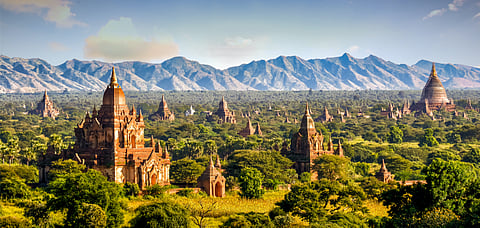
- Destinations
- Experiences
- Stay
- What's new
- Celebrating People
- Responsible Tourism
- CampaignsCampaigns
- SubscribeSubscribe
- Buy Now

The Archaeological Survey of India (ASI) has started the restoration of five pagodas in Bagan&rsquos ancient cultural zone, according to Myanmar&rsquos Archaeology and National Museum Department. The newspaper clipping giving the details was recently posted by 'India in Myanmar', the official Facebook page of the Indian embassy there.
A UNESCO World Heritage Site (inscribed in July 2019), Bagan is one of the most popular attractions of Myanmar. Located in the Mandalay region, it is home to a splendid display of Buddhist art and architecture. It was the capital of the Pagan kingdom &ndash the kingdom which unified regions that constitute the Myanmar of today &ndash between 9th and 13th centuries. Located on the eastern bank of the Ayeyarwady River, over 3,000 ancient monuments and pagodas are strewn all over Bagan. These include temples, stupas, monasteries and places of pilgrimage. Many of these monuments are embellished with frescoes and sculptures. According to UNESCO, these monuments demonstrate &lsquocenturies of the cultural tradition of the Theravada Buddhist practice of merit making (Kammatic Buddhism)&rsquo, and belongs to the peak of the Pagan period (11th to 13th centuries).
Divided into eight serial components, according to UNESCO, &lsquothe serial property of eight components consists of 3,595 recorded monuments &ndash including stupas, temples and other structures for Buddhist spiritual practice, extensive archaeological resources, and many inscriptions, murals and sculptures. Bagan is a complex, layered cultural landscape which also incorporates living communities and contemporary urban areas.&rsquo Similar to Hampi (Karnataka) in India, seven of the components are located on one side of the Ayeyarwady River, and one on the opposite side.
Unfortunately, many of these monuments, owing to neglect and natural calamities, were in various state of disrepair. According to UNESCO, &lsquothe authenticity of Bagan is demonstrated by the landscape of Buddhist monuments of diverse sizes, scales, materials, designs and antiquity and the rich and continuing religious and cultural traditions.&rsquo However, the international body pointed out that the authenticity of some monuments &lsquohas been impaired by inappropriate interventions from the 1970s and 1990s, and by the extensive damages that resulted from earthquakes.&rsquo
Four years of rehabilitation work conducted by local and foreign experts repaired and restored 365 pagodas to UNESCO standards, according to media reports.
The five pagodas, which are being restored by the ASI, were damaged during a severe earthquake in 2016. The ASI has started emergency maintenance work as the restoration will take years. Talking to Myanmar Times, U Soe Soe Lin, deputy director of the Archaeology and National Museum Department in Bagan, said, &ldquoEmergency maintenance for integrity will be done this year, and the rest will be done step-by-step after doing research on the structures.&rdquo
Prior to this, the ASI had also restored the Ananda Temple in Bagan, working on its structural conservation and chemical preservation work, after an agreement was signed between the two nations in 2010. This temple, considered a masterpiece of Mon architecture, was built around 1105 by King Kyansittha of Myanmar.
